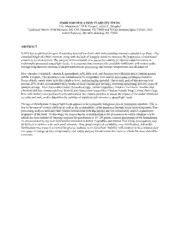
NASA Technical Reports Server (NTRS) 20140013146: Food Fortification Stability Study PDF
Preview NASA Technical Reports Server (NTRS) 20140013146: Food Fortification Stability Study
FOOD FORTIFICATION STABILITY STUDY T.O. Abdulmalik1, M.R. Cooper1, and G.L. Douglas2 1Lockheed Martin, 1300 Hercules, MC C09, Houston, TX 77058 and 2NASA Johnson Space Center, 2101 NASA Parkway, MC SF4, Houston, TX 77058. ABSTRACT NASA has established the goal of traveling beyond low-Earth orbit and extending manned exploration to Mars. The extended length of a Mars mission, along with the lack of resupply missions increases the importance of nutritional content in the food system. The purpose of this research is to assess the stability of vitamin supplementation in traditionally processed spaceflight foods. It is expected that commercially available fortificants will remain stable through long-duration missions if proper formulation, processing, and storage temperatures are all achieved. Five vitamins (vitamin E, vitamin K, pantothenic acid, folic acid, and thiamin) were blended into a vitamin premix (DSM, Freeport, TX); premixes were formulated to be compatible with current processing techniques (retort or freeze-dried), varied water activities (high or low), and packaging material. The overall goal of this process is to provide 25% of the recommended daily intake of each vitamin (per serving), following processing and two years of ambient storage. Four freeze-dried foods (Scrambled Eggs, Italian Vegetables, Potatoes Au Gratin, Noodles and Chicken) and four thermostabilized foods (Curry Sauce with Vegetables, Chicken Noodle Soup, Grilled Pork Chop, Rice with Butter) were produced (with and without the vitamin premix), to assess the impact of the added fortificant on color and taste, and to determine the stability of supplemental vitamins in spaceflight foods. The use of fortification in spaceflight foods appears to be a plausible mitigation step to inadequate nutrition. This is due to the ease of vitamin addition as well as the sustainability of the premixes through initial processing steps. Post- processing analysis indicated that vitamin fortification with this premix did not immediately impact organoleptic properties of the food. At this stage, the largest hurdle to fortification is the preciseness to which vitamins can be added; the total amount of vitamins required for production is 10 - 20 grams, a minor percentage of the formulation. As demonstrated by the over-fortification measured in Italian Vegetables and Grilled Pork Chop, homogeneity may be difficult to achieve with such small amounts. Thus, pouch-to-pouch variability, over-fortification, and under- fortification may ensue if a method for precise addition is not identified. Stability will continue to be evaluated over two years of storage at three temperatures, and future analysis should reveal the extent to which this issue should be a concern.
